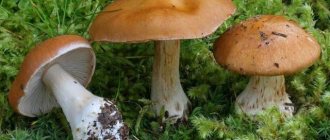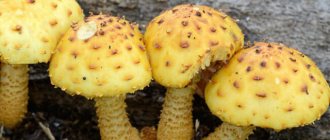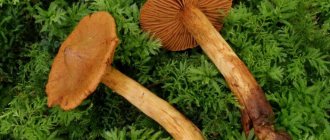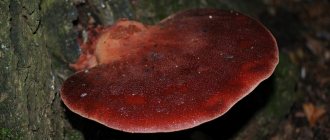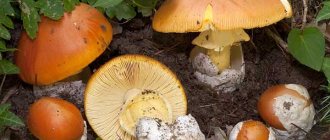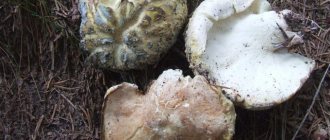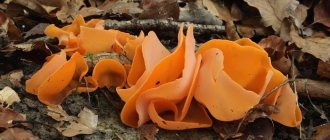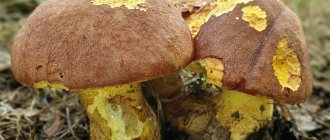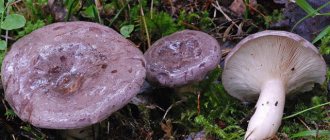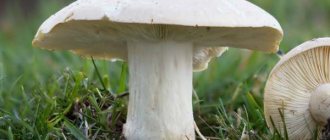The triumphal cobweb is the most popular and delicious representative of the Cobweb family. It is also called yellow webweed or marshweed. This mushroom received its majestic name due to the golden-yellow color of the cap, reminiscent of the wreath of the ancient Roman triumphant commanders.
In foreign countries, the question of whether it is edible or not is decided in favor of inedibility. In Russia, the triumphal cobweb is widely used for culinary purposes and is famous for its excellent taste.
What does a yellow spider web look like?
The photo of the yellow cobweb, which is also called the yellow marshweed or triumphal cobweb, shows that the mushroom has a fairly recognizable external structure. It belongs to the lamellar variety and is easily recognized by its cap shape and characteristic color.
Description of the cap
Photos and descriptions of the yellow webweed show that the size of the cap of the yellow webwort is average, from 6 to 12 cm, at a young age it is half spherical, but over time it becomes prostrate and cushion-shaped. The color of the cap is orange-yellow, darker in the center and lighter towards the edges. Its surface is usually sticky and slimy, it dries out only in very dry weather, and fragments of a cobwebby blanket are often visible along the edges.
The photo of the edible mushroom yellow cobweb shows that the lower surface of the cap is covered with frequent and narrow plates - light cream in young mushrooms and bluish-brown in adults. In early fruiting bodies, the plates are usually completely covered with a cobwebby covering.
If you break the cap of the yellow marsh grass in half, the flesh will be soft and dense, of a white-yellow hue. The smell of the mushroom is pleasant, which is generally uncharacteristic of cobwebs.
Description of the leg
Above the ground, the yellow triumphal cobweb usually rises 8-15 cm, and the coverage of the white leg is only up to 3 cm. In young fruiting bodies, a strong thickening is noticeable in the lower part of the leg. Over time, the shape becomes regular and cylindrical. Uneven ring-shaped spots of a red-brown color can be clearly visible on the leg.
Description
The triumphal spider plant belongs to the family Cortinariaceae, genus cortinarius. The mushroom cap is hemispherical, but can be either convex or flat. Color - yellow-orange. The surface of the cap is sticky, but can dry out in hot weather. The pulp is dense, soft, yellow in color with a white tint. It has a mushroom smell and a bitter taste . The plates that are located at the bottom of the cap are dark and can stain your hands when touched. The leg of the spider web is from 8 to 15 cm long, widened at the base, yellow in color with small light veins.
Where and how does it grow
The yellow web spider is quite widespread throughout Eurasia and Russia. It grows mainly in deciduous forests next to birches; it can also be found in coniferous forests where birches are present. Despite the second name, marsh grass, yellow spider web is quite rare near lakes and swamps. It can be seen much more often on dry soils and in bright places.
Important! Often the yellow cobweb grows next to the black milk mushroom and is even considered a companion of this mushroom.
When do yellow spider webs grow?
You need to go to the forest for yellow marsh marshes closer to autumn. The first fruiting bodies appear in early August, and mass fruiting occurs in September, the same period when black milk mushrooms bear fruit. It makes sense to look for these mushrooms in pairs - most often they accompany each other. The growth of yellow spider webs continues until October and the first frost.
Spreading
Cobwebs have been recorded from high latitudes in subalpine forests throughout the northern hemisphere, including subalpine coniferous forests in the Yatsuk Atake Mountains in Yamanashi Prefecture in central Japan. In North America, this species is found in British Columbia and western Washington, especially Mount Rainier National Park. Noble webwort can also be found in the northern British Isles, usually in damp areas of coniferous or mixed coniferous and broadleaf woodland, although it is rare. Because members of the genus Cortinarius are mycorrhizal, they have co-evolved with their symbionts and therefore occupy limited ecological niches. The noble cobweb, like most members of the family, forms a symbiosis with deciduous trees (especially oak), and sometimes it can be found under coniferous trees, both on alkaline and acidic soils.
Doubles and their differences
Despite the recognizable appearance of the yellow marsh grass, it can be confused with other similar species. Among them there are both edible and poisonous mushrooms, so before going into the forest you should carefully study the photos of the yellow cobweb and false doubles.
Common web spider
This species has a yellow cap with an olive or brownish tint, so it resembles a yellow marsh grass. Mushrooms can be distinguished by their stems - in the ordinary species they have a slight purple tint.
This mushroom grows in the same places as the yellow marsh grass - in deciduous and mixed forests, next to aspen and birch trees. Massive fruiting occurs from July to September; it is not suitable for use as food, it is inedible.
Bracelet webwort
The mushroom belongs to the category of conditionally edible and is edible after preliminary processing. The structure of the bracelet webwort resembles the yellow marshweed, but there are also important differences. In particular, the cap of the first species is dry, not wet, and orange or slightly reddish in color. The surface of the cap is covered with dark villi; dark red bands can be seen on the stem.
The twin grows mainly under birch and pine trees on moist soils. It actively bears fruit at the same time as the yellow spiderwort - from August to November.
The most beautiful spider web
The most dangerous of the yellow marsh grass's counterparts can be considered the most beautiful spider web. Despite the attractive name, this mushroom is poisonous and unsuitable for food consumption. You can distinguish it from the photo and description of the yellow cobweb mushroom by the red-orange color of the cap and the presence of small scales.
The leg of the mushroom is also red-orange, and the stripes on it are ocher or lemon yellow. The beautiful spider web grows mainly in coniferous forests, and the peak of fruiting occurs from May to September.
Varieties of mushroom
Although this is a rare mushroom, it still has several types. Some of them are edible, some are poisonous (Figure 3).
Figure 3. Main types of spider webs: 1 - scaly, 2 - yellow, 3 - white-violet, 4 - special
Here is the complete list:
- Scaly: has a shiny, slimy cap up to 10 cm in diameter. If you smell the mushroom, you can hear a distinct musty smell. The color of the cap is gray-violet. The surface is loose.
- Yellow: This is a poisonous species. Its distinguishing feature is its yellow cap. The smell is practically inaudible.
- The cobweb is white and purple: at first glance, it seems that the fleshy cap seems to be fused with a thick leg. The cap can grow up to 12cm in diameter. Its flesh is brown in color and pleasant to the taste.
- The most special: poisonous species, equivalent to the pale grebe. Even in small doses it can lead to irreversible processes in the body. Be careful when you meet him. Cream colored hat. The pulp smells like raw potatoes.
- Shiny cobweb: has a beautiful brown shiny cap. It is also poisonous. At the break, lemon-yellow flesh with the aroma of fresh bread is visible. The shade of the leg is light, with fluff at the base.
- Noble: its toxicity is just off the charts! Affects the renal system. The fruit body is dark yellow, the flesh is also yellow. The cap is small in diameter, up to 6 cm.
- Blue-stemmed webwort: it can be eaten. The cap is buffy-brown, sometimes with an olive tint. The surface is covered with mucus. The leg can be white or purple and also slimy. The pulp is also white and tasteless. There is no smell.
Figure 4. Other varieties of spiderwort: 1 - shiny, 2 - noble, 3 - blue-trunked To learn how to distinguish poisonous mushrooms of this variety from edible ones, we recommend studying their features in the photo (Figure 4).
How to cook yellow spider webs
The mushroom can add a pleasant variety to your usual diet, but to do this you need to know how to properly prepare the edible yellow spider web. Before any processing, it needs preliminary preparation that will make it safe for consumption.
Preparing mushrooms
There is no need to soak the triumphal marsh grass before use. It is enough to clean the fruit bodies from forest debris and soil residues, rinse them in running water and cut off all the wormy and rotten areas on the caps and stems.
Preliminary preparation boils down to boiling. You need to cook the spider web in salted water for about 20 minutes after boiling, constantly skimming off the foam. The water from under the mushrooms must be drained, and the fruiting bodies themselves are thrown into a colander, after which they are subjected to further processing.
How to cook fried yellow cobweb mushrooms
A popular recipe for making pribolotniks is frying them with onions. First, in a heated frying pan greased with vegetable oil, fry about 150 g of finely chopped onions until they become transparent.
After this, add 500 g of boiled mushrooms to the onions, salt and pepper to taste, and then fry for another 5-10 minutes. The finished side dish is consumed together with boiled potatoes or as an independent dish.
How to pickle yellow spider webs
To preserve for the winter, pickling of yellow spider webs is practiced. The recipe is very simple:
- fresh mushrooms are boiled for 15 minutes;
- At the same time, prepare a classic marinade - add 2 teaspoons of sugar, 1 teaspoon of salt, an umbrella of dill, a couple of cloves of garlic and a few black peppercorns to 1 liter of water;
- after boiling, add 2-3 large tablespoons of vinegar and after a couple of minutes remove the marinade from the stove;
- mushrooms are placed in sterilized jars and poured with hot marinade.
The jars need to be rolled up tightly, turned upside down and wrapped in a warm blanket until they cool. After this, the pickled spider web can be stored in the refrigerator.
Beneficial features
The web spider cannot be called harmless. Many members of this family are toxic, and some are even life-threatening. However, the beneficial substances that make up these mushrooms are widely used in medicine and the chemical industry. The following types are used for medicinal purposes:
- Red (poisonous). The substances included in its biochemical composition prevent the development of tuberculosis.
- Bracelet (conditionally edible). Has an antiseptic effect.
- Broken (poisonous). It contains alkaloids that are used in the treatment of diseases associated with memory impairment.
- Goat (inedible). It contains inolomine, which is a strong antibiotic.
There are quite a few edible species. They do not have the same aroma as porcini mushrooms or champignons, but they have an original taste and are large in size (up to 10 cm in stem height and up to 17 cm in cap diameter). Professional mushroom pickers enjoy collecting them for preparing fresh dishes and preserving them.
In culinary masterpieces, yellow webwort (also called triumphal), watery blue (sometimes called dove-blue), as well as superb and purple webwort are often used. All types of edible mushrooms can be boiled, fried, pickled, salted and canned.
Recipes for preparing yellow spider webs for the winter
If desired, the edible yellow spider web mushroom can be preserved throughout the winter. There are 3 main recipes for processing for long-term storage.
Drying
Dried botanicals are preserved for a long time; they can be added to soups and main courses. It is customary to dry mushrooms fresh, without boiling. The fruiting bodies are cleared of debris, and then, without washing, they are strung on a thin thread. The bunch should be hung in a well-ventilated and sunny place and wait until all the moisture has evaporated from the pulp.
An alternative method is oven drying. In this case, the fruiting bodies are laid out on a baking sheet and placed in an oven preheated to 70 °C. From time to time, the marshlands need to be turned over. Drying takes about 6 hours; after the mushrooms have cooled, they are placed in a dry container and stored in a dark place.
Salting
Pickling is the simplest and most popular recipe for preparing yellow spider web mushroom. The boiled gifts of the forest are placed in layers in a jar, sprinkling each layer with salt; if desired, you can also add dill seeds and pepper. When the jar is filled to the top, its neck is covered with gauze, and heavy oppression is placed on top.
After a couple of days, the mushrooms will be completely covered with the released juice, and after another 3 weeks, the cobwebs can be put on the table.
Attention! The last layer in the jar should not be mushrooms, but salt. During the salting process, the gauze covering the neck must be replaced with a new one from time to time, otherwise mold will grow in it.
Canning
Another recipe suggests preserving bogwort in oil to preserve its beneficial properties for the winter. The peeled fruiting bodies are boiled in salt water for 40 minutes, and then placed in jars and filled with broth. To it you need to add 2 large tablespoons of vegetable oil, 3 cloves of garlic, 3 horseradish leaves and 3 dill umbrellas. The jars are tightly sealed, cooled and stored in the refrigerator. You can use homemade canned food throughout the winter.
Restrictions and contraindications
Since the yellow spider web does not contain toxic substances, its contraindications are exactly the same as those of most mushrooms. It is not recommended to use it if:
- chronic liver diseases;
- pancreatitis;
- tendency to constipation;
- individual intolerance.
It is also better for pregnant women and nursing mothers to avoid the marsh plant. You should not offer marsh grass to children under 7 years of age, as their digestive system will not be able to handle it.
Advice! You should consume no more than 150 g of mushrooms per day, since the botanical mushroom contains a lot of protein and is poorly digested in excess quantities.
Interesting facts about yellow web spiders
There are several facts associated with yellow marshlands that mushroom pickers will be interested to know about:
- The second name of the mushroom, triumphal cobweb, is due to its golden hue, reminiscent of the color of the golden crown of Roman generals.
- Since the yellow cobweb often grows next to the black milk mushroom, mushroom pickers often refuse to collect it, opting for the more famous mushroom. Therefore, cobwebs do not appear in recipes as often as they could.
- If you break the cap of the marsh grass in half, its flesh will not change color, but will dry out quite quickly.
Many mushroom pickers note that yellow cobwebs, when boiled, produce a very clear and beautiful broth. Interestingly, after processing, the mushroom retains its shape and has a pleasant crunchiness.
Application
The season for collecting yellow spider webs occurs during the growth of more edible and useful mushrooms, so mushroom pickers usually avoid them.
Yellow spider webs are rarely used in cooking, as different sources interpret its edibility differently. Also, the recipes according to which it is prepared are not so common.
People call cobweb mushrooms that are found in different types of forests. Some adherents of a healthy lifestyle eat the fruiting bodies raw, and they are also tasty when salted. A distinctive feature of these representatives of the natural kingdom is a kind of white “veil” located on the lower part of the cap and descending onto the stem.
People call cobweb mushrooms that are found in different types of forests
Scientists have identified mushrooms belonging to the Pautinnikov family in the order Agaricaceae. Popularly, the described representatives of the natural kingdom are called marshlanders, and you can recognize them in the forest by the characteristic cobwebby formation in the lower part of the fruiting body.
The shape of the cap varies from hemispherical to conical, and both smooth and fibrous specimens are found. The color of mushrooms can vary and fades with age.
The flesh of the cap can be fleshy or, on the contrary, thin; the color of the fruiting body on the cut may change. The stem of the mushroom is club-shaped, less often cylindrical and with a tuberous thickening at the bottom; there is always a remnant of the “veil” on it. It is curious that it is clearly visible only in young specimens; the old fruiting bodies, the described part remains in the form of a coating.
